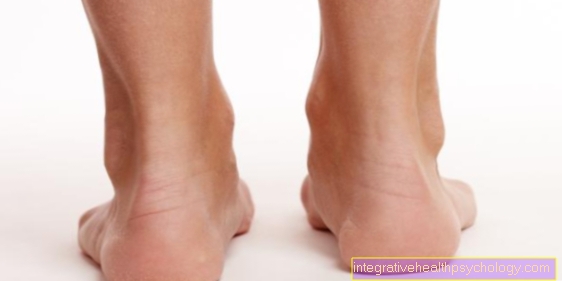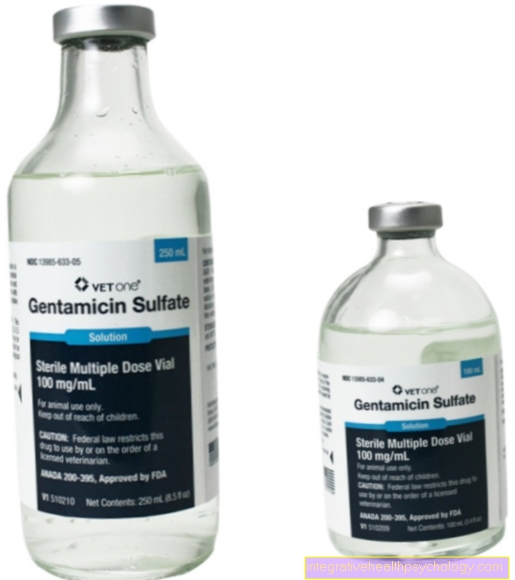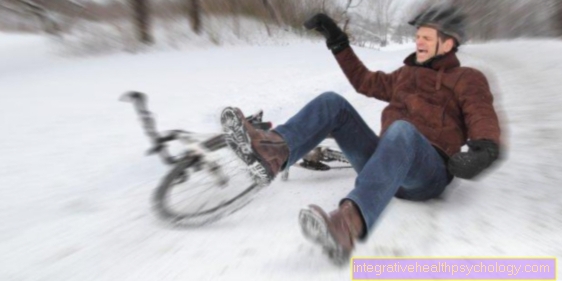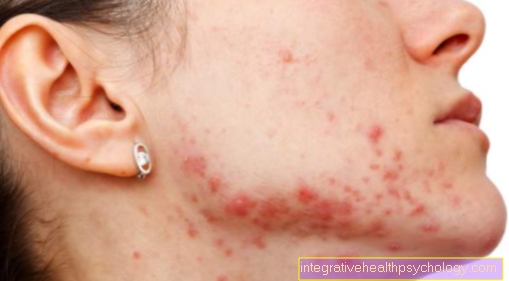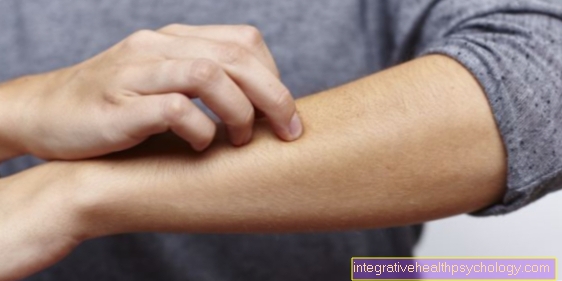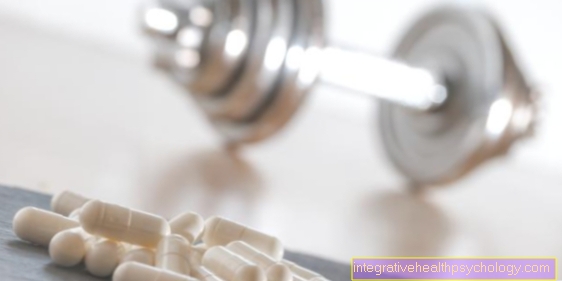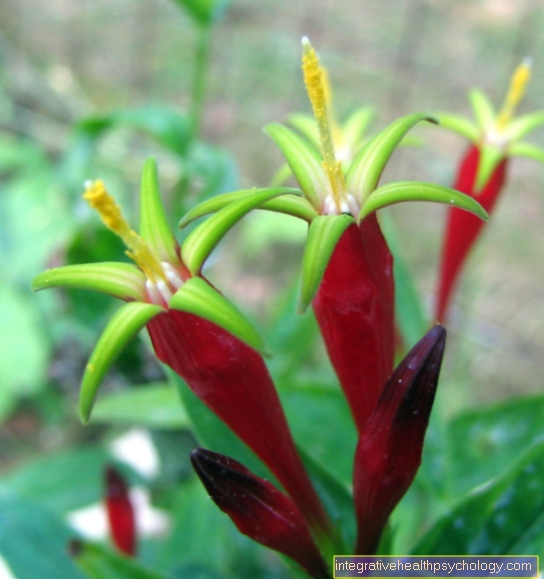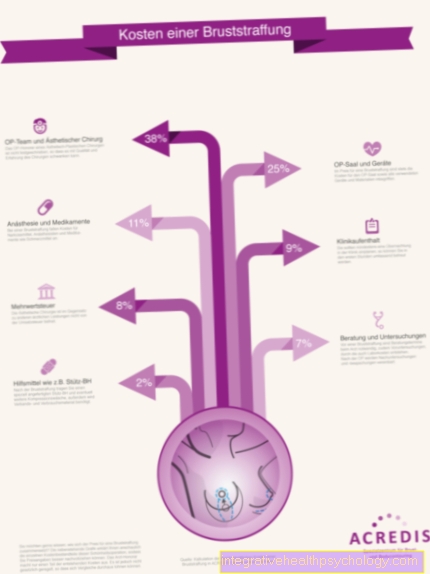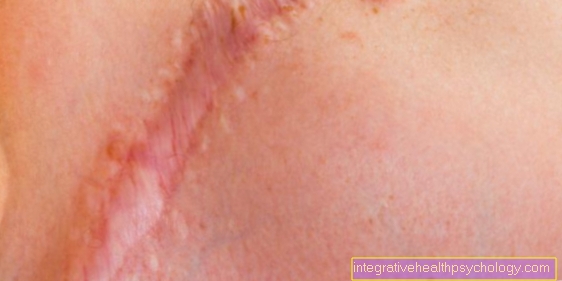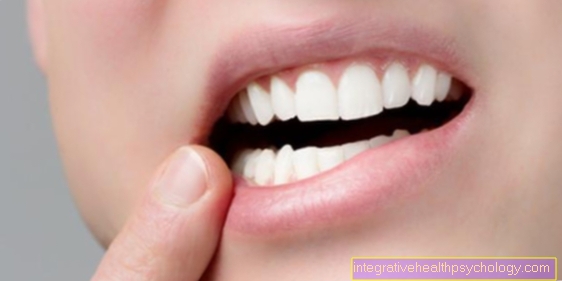Nasal septum
Synonyms
Nasal septum, nasal septum
anatomy
The nasal septum divides the main nasal cavities into a left and a right side. The nasal septum thus forms the central border of the nostrils (Nares).
The nasal septum forms with a posterior bony (Vomer and Lamina perpendicularis ossis ethmoidalis), a middle cartilaginous (Cartilago septi nasi = Alar cartilage and square cartilage) and an anterior membranous part with the nostrils the externally visible shape of the nose.
The cartilaginous and bony parts, like the rest of the main nasal cavities (Cavum nasi) and the sinuses (Paranasal sinus), covered by mucous membrane.
The olfactory epithelium is located on the upper edge of the nasal septum and on the upper turbinate (opposite).
A plexus of blood vessels (Locus Kiesselbachi) ensures blood flow, especially in the front area of the nasal septum.

Diseases of the nasal septum
Mechanical manipulation, for example drilling your nose or frequent blowing your nose, can irritate or injure the sensitive mucous membrane and it can lead to small bleeding (nosebleeds).
Especially dry heated air can lead to the drying out of the mucous membrane on the nasal septum during the cold season.
Small cracks appear, which heal within a few days through care of the mucous membrane.
Furthermore, typical mucosal infections such as bacterial infections or fungal infections can also affect the area of the nasal septum.
The use of cocaine, Wegener's disease or syphilis can lead to a hole in the nasal septum (Septal perforation) to lead. This should be closed surgically.
Deformations of the nasal septum can be genetic and therefore congenital. For example the hump and hooked noses. On the other hand, the saddle nose and the crooked nose have been acquired.
Violence against the midface can lead to bleeding between the cartilage and the mucous membrane. This nasal septal hematoma can become infected and lead to the septal abscess. There is a risk of cartilage cells perishing (Cartilage necrosis), which is why surgical evacuation of the hematoma within 24 hours is recommended for a nasal septal hematoma.
Depending on the cause and type of deformation, a nasal septal correction can be performed.
A nasal septal deviation (misalignment of the nasal septum) is often the cause of restricted nasal breathing or snoring. Often the nasal septum is inclined even if the nose appears to be straight on the outside, but this is not noticed by the person because there are no symptoms. A misalignment of the nasal septum alone is therefore not a reason for treatment.
For more information on the subject, read below: Diseases of the nose
The nasal septum has a hole
A hole in the septum is called a nasal septum perforation and can be caused by many different causes. In addition to traumatic events such as a blow or a mistake during an operation, chronic inflammation can also create a hole in the long term.
Risk factors for a hole in the nasal septum are long-term exposure to industrial dusts and regular use of drugs.
This hole is noticeable through obstructed nasal breathing, bleeding, pain, a whistling whistle when breathing and crust formation. These crusts are often infested with bacteria and can produce an unpleasant odor.
If a nasal septum perforation is suspected, a doctor should be consulted, as the disease and thus the symptoms do not improve on their own.
The doctor examines the nasal septum to confirm the diagnosis. For this purpose, a camera with a light, a so-called rhinoscope, is inserted into the nose.
The therapy consists in the surgical closure of the hole by a cartilage transplantation of the body's own cartilage, mostly from the ear. Despite a successful operation, the cause should be fought. If, for example, exposure to industrial dust continues or if the chronic inflammation is not treated, a new hole in the nasal septum is likely to appear again.
You might also be interested in our next topic: Pain in and around the nasal bone
Examination of the nasal septum
Since the nasal septum is already partially visible from the outside, the external inspection can identify a tilt, a hump, piercings or even external infections and thus obtain information about the problem at hand.
As a rule, this is followed by the examination using a speculum. The doctor carefully dilates the nostril with a small spreader and, in the best case, can use turbinates (Conchae nasales), nasal cavity (Cavum nasi) and of course the nasal septum (Nasal septum) judge.
OP & straightening of the nasal septum
An operation on the nasal septum is usually only treated if there are symptoms related to a curvature.
The symptoms range from shortness of breath to snoring, frequent respiratory infections to problems with smelling and headaches or migraines. All of them are based on a curvature of the nasal septum, which is straightened out during the operation.
Both the bony and the cartilaginous parts can be affected by the curvature. Usually this curvature occurs as a result of uneven growth of the jaw, the palate and the nose or the nasal septum. In addition, after a rupture of the nasal septum as a result of a blow or a fall, it comes together more crookedly, which can cause the above-mentioned problems.
On the basis of the complaints and the findings of the doctor, the indication for an operation is made, whereby the extent of the complaints is an important criterion for the doctor. Even if the physical examination is abnormal, no operation will be performed if the patient is completely symptom-free.
During the physical examination, which includes a nasoscopy, a special device is inserted into the nose using a nasal spray to assess the condition of the mucous membrane and bony and cartilaginous structures. In addition, a curvature of the nasal septum can often be assessed from the outside.
The operation is usually carried out under general anesthesia, but in special cases it can be done under local anesthesia. In order to get to the bony and cartilaginous parts of the nasal septum during the operation, the mucous membrane is separated from them with a scalpel. Then these structures are separated from the surrounding skeleton and the nasal septum is removed.
For the straightening, the partition is now divided into small individual parts and reassembled to form a flat surface.
The realigned nasal septum is now inserted into the nose and covered with the mucous membrane while being fixed to the surrounding tissue.
Complications are rare with this operation, but damage to the mucous membranes, sensory disturbances, bleeding and recurving may occur.
In children, it is important to note that the operation does not destroy any growth areas of the bone, as this can cause more severe problems with increasing age.
After the operation, the nose should be spared. Plastic plates can be used for this, but they can be removed within a week. The bleeding is relieved by tamponade.
In the following days, the body reacts with increased secretion production, which can clog the airways, which is why it should be suctioned if possible. Failure to do this increases the risk of inflammation in the sinuses.
For this reason, an antibiotic is often prescribed prophylactically. In order to prevent excessive stress, sports and other physical work should be avoided completely. Furthermore, sneezing, sunbathing or hot showers can lead to profuse bleeding.
Since healing can take up to a few weeks, the course should be checked regularly by a doctor for up to six weeks after the operation in order to be able to quickly counter any problems that may arise. The mucous membrane needs this time for complete regeneration and the straightened nasal septum needs to grow together completely.
Even after the medical check-ups, the mucous membrane can be moistened and cared for with various ointments or rinses if necessary, as it is still very sensitive.
You can find more information on this topic here: Nasal septum OP
Illustration of the nose and throat

- Upper turbinate -
Concha nasi superior - Upper nasal passage -
Superior nasal meatus - Middle turbinate -
Concha nasi media - Middle nasal passage -
Meatus nasi medius - Lower turbinate -
Concha nasi inferior - Lower nasal passage -
Inferior nasal meatus - Atrium of the nasal cavity -
Vestibulum nasi - Olfactory threads - Fila olfactoria
- Olfactory bulb - Olfactory bulb
- Rear opening of the
Nasal cavity - Choana - Nasal cavity - Cavitas nasi
- Pharyngeal almond -
Pharyngeal tonsil - Frontal sinus - Frontal sinus
- Sphenoid sinus -
Sphenoid sinus - Oral cavity - Cavitas oris
- Tongue - Lingua
You can find an overview of all Dr-Gumpert images at: medical illustrations



